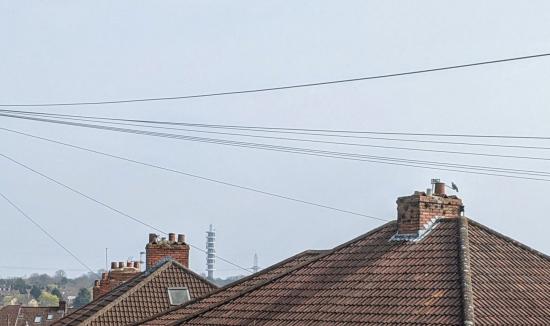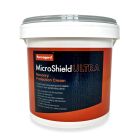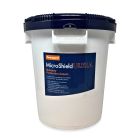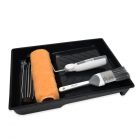Help & Advice Articles, Videos and How-to-Guides
Filter Articles

A guide to chimney waterproofing
When masonry and brickwork are constantly exposed to weather (in particular moisture and temperature extremes), they will gradually degrade over time unless protected. External chimneys are no exception - they are vulnerable to the elements from all angles without any surrounding cover. Brickwork and masonry is very porous which means that chimneys in the UK are very susceptible to water damage and issues that come as a result.
When the masonry degrades you can end up with both cosmetic damage to the external chimney stack and also deeper structural problems such as wet rot, spoilage and penetrating damp. From a maintenance perspective, remedial works on a damaged chimney and wet rot are very tricky to carry out, and time-consuming and costly.
Chimney waterproofing is a proactive step you can take to protect chimney brickwork from water damage. A reputable chimney water repellent will line the pores in the brickwork and mortar and prevent moisture from penetrating further where it can cause damage. This helps prolong the life of the flue, and protect the rest of the building.
In this short guide we’ll cover everything that professionals need to know about spotting chimney defects and carrying out best practice chimney waterproofing.
Why are chimneys vulnerable?
As mentioned, external chimneys are constantly exposed to the elements which includes regular rainfall, freezing temperatures and strong winds. In the UK, this kind of weather is frequent which accelerates the rate of wear on a building’s chimney stack, cap and flashing.
Unlike penetrating damp, condensation and rising damp, water damage and ingress is especially hard to spot on a chimney due to its location and ease of access. This means that issues won’t become known until the signs of damp become severe. The following are examples of problems that may arise from a lack of chimney protection.
Chimney spalling caused by freeze-thaw cycle
A freeze-thaw cycle is used to describe the repeated process in which water absorbed into a chimney’s brickwork freezes, and then thaws. When water freezes it expands which can cause cracking throughout a chimney’s brickwork. When you have a freeze-thaw cycle, the condition of bricks can deteriorate rapidly as the cracks will widen and take in more moisture which will freeze and expand once more.
Water ingress related chimney issues
Once water has penetrated the brickwork, it can progress throughout the stack and below the roofline. If the ingress has advanced enough, it can start to make contact with the roof’s timber elements like rafters and collar beams causing:
- Wet rot
- Dry rot
- Structural decay
- Interior wall spoiling
- Mould
- Musty smells
Algae and lichen growth on chimneys
Algae and moss require a constant source of moisture to stay alive which is why their presence on the outside of a chimney’s brickwork indicates an issue. These organisms store water at their roots which presses it up against the masonry to exacerbate the freeze-thaw cycling effect.
Identifying Chimney water damage
We always recommend taking a proactive step and waterproofing your chimney to prevent water damage. It’s still useful to be able to spot the signs of chimney damage early on and stop further damage developing and causing more severe problems. Regular building maintenance checks are a good way to assess the physical state of a chimney but you should also look out for these signs too:
- Visible masonry damage - Cracks in the brickwork and mortar joints mean that water has a way of penetrating the chimney and causing freeze-thaw problems
- Efflorescence - The presence of a milky residue on the brickwork surface indicates that water has breached the chimney structure. This demonstrates that water has been able to move through the brickwork, collect water-soluble minerals and deposit them on the surface
- Algae and moss - The presence of small plantlife organisms such as moss and algae are a telltale sign of established moisture. Algae and moss can’t exist without a constant supply of moisture so any signs of it on the outer chimney structure could be a giveaway
- Odour - When water has penetrated a building through the chimney, it can start to cause mould and rot on the ceilings, walls and other timber components. This can cause a musty smell throughout the building, and lead to the health hazards associated with mould.
Chimney waterproofing products from Permagard
Microshield Ultra is a tried and tested masonry waterproofing cream that can be applied to brickwork and natural stone, making it the perfect product for chimney waterproofing. When applied, Microshield Ultra lines the masonry pores with silicone to create a completely impermeable barrier against water deep within the brickwork rather than just on the surface. At the same time, the organic silane and siloxane contained within Microshield Ultra allows water vapour to escape. This offers a breathable solution that lowers the risks of condensation. It also helps prevent algae growth, spalling and offers protection from water damage.
All of this can be achieved with a single coat applied by brush or roller and will prevent water ingress for a number of years. The active ingredients also create a beading effect for 2-3 years depending on weather intensity - this is when water beads on the surface of the chimney. A coat of Microshield Ultra can also make a structure more thermally retentive by preventing heat from being drawn out by damp cold walls. This is especially useful for a chimney area.
How to waterproof a chimney with Microshield Ultra
Waterproofing a chimney with Microshield Ultra is simple, clean and fast. You’ll need:
- Microshield Ultra 5L - Masonry Waterproofing Cream
- Masonry roller
- Masonry brush
- Mortar
- Repointing gun
- Anti-mould wash
How many chimneys do you need to waterproof?
If you are working on a large building or multiple buildings where there are more than one chimney, you’ll need to plan how much Microshield Ultra product you’ll need. An easy way of doing this is to estimate the total rough area of the surface you’ll need to cover and then buying the product accordingly. Roughly, one 5L tub of Microshield Ultra will provide a good cover for an area between 20-25m². To calculate how much Microshield Ultra you’ll need simply follow this formula:
- Total estimated area for coverage / 20 = number of 5L tubs needed
We also offer Microshield Ultra in 20 litre tubs for large scale projects. If you are working on such a project and need to Microshield Ultra in bulk quantities, use the formula below:
- Total estimated area for coverage / 80 = number of 20L tubs needed
Prepare the substrate
Before applying Microshield Ultra, you’ll need to assess the condition of the substrate including the stack, cap or any other part of the chimney. If there are cracks in the mortar or bricks then you should repoint them using masonry concrete while replacing any worn base flashing. Depending on the chimney’s condition, you may need to carry out crack stitching. Algae and lichen will also need to be removed from the affected area with a paint scraper.
Protect other surfaces
Microshield Ultra will leave a visible white coating when applied so that you can see where you’ve applied it. We recommend masking off any non-masonry areas you wish to protect using cloths, sheets and hard-wearing duct tape. You should tape up both the cap and base flashing while wrapping the flue cover. We recommend covering the surrounding roofing tiles with sheeting just in case of any flicks and drops.
Apply Microshield Ultra to the chimney
When the chimney has been prepared and is ready, apply one coat of Microshield Ultra in mild conditions with a dry spell predicted. Use a roller to cover the large areas, but then use a masonry paint brush for hard to reach locations like the mortar trenches, crown underside and areas leading up to the base flashing.
External chimney waterproofing with Permagard
Carrying out external chimney waterproofing is a way to secure your home from concealed water damage that can become more severe as time goes on. Our guide has highlighted what you need to look out for as well as the materials and products you need to successfully prevent water ingress through an external chimney.
Our chimney waterproofing products are industry-renowned and can be shipped in bulk or smaller quantities for both small and professional jobs. All products are dispatched immediately and delivered within 48 hours.
Are you working on a large-scale chimney waterproofing project? Call our dedicated team for a consultation today on 0117 982 3282.



